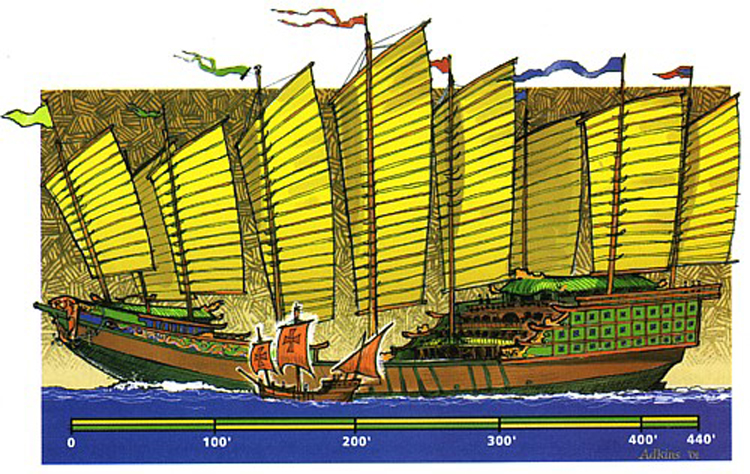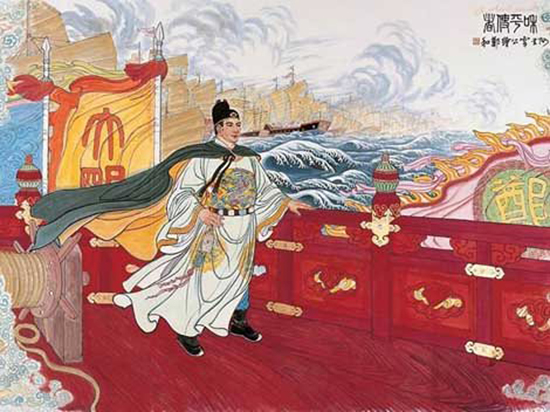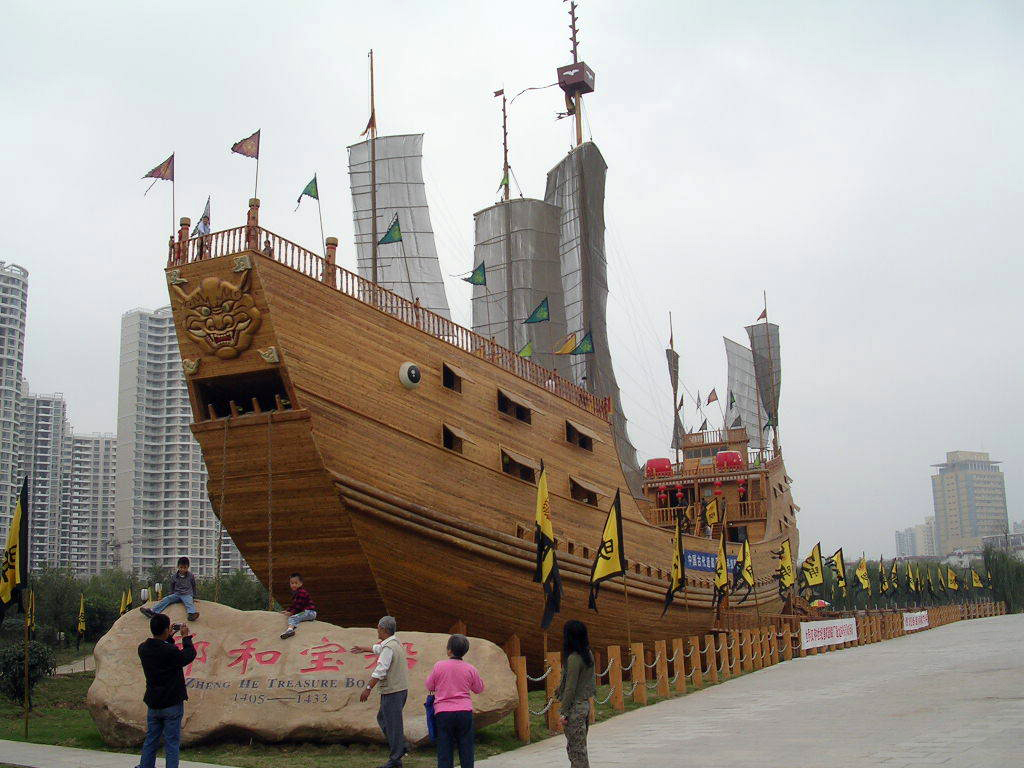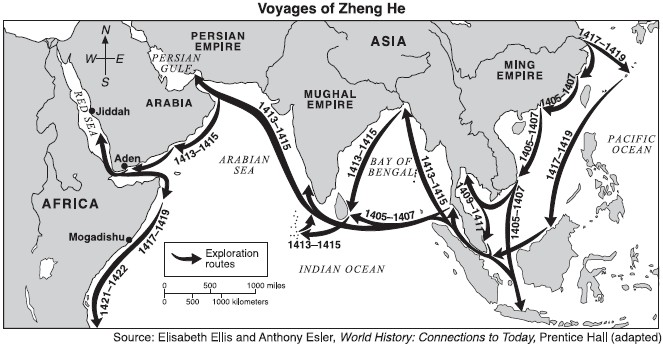by Islam El Shazly
When asked who were the first world-class Navigators are, Christopher Columbus and Vasco da Gama are first names that come to mind for almost anyone who read a bit of history. But there’s one that predates both of them, with a fleet that put both their fleets combined to shame. His fleet was proof that at times bigger is better and stronger.
Over 300 large treasure ships, troop ships, horse ships, water and store ships, and smaller escort or attack vessels. 28,000 crewmen and soldiers.
These are the voyages of Sanbao (Three Jewels) to the Western Ocean.
Ma He (Hajji Muhammad Shams), as he was originally known, was born in 1371 to an ethnic Hui (Chinese Muslims) family in Yunnan Province, Southwest China. In 1381 his father was killed following the defeat of the Northern Yuan, a Ming army was dispatched to Yunnan to put down the Mongol rebel Basalawarmi. Barely eleven years old, he was ritually castrated and sent to the Imperial court, where he was called ‘San Bao’ meaning ‘Three Jewels.’ He eventually became a trusted adviser of the Yongle Emperor (r. 1403-1424), assisting him in deposing his predecessor, the Jianwen Emperor. In return for meritorious service, the eunuch received the name Zheng He from the Yongle Emperor.
Between 1405 and 1433, the Ming government sponsored a series of seven naval expeditions. They were designed to establish a Chinese presence, impose imperial control over trade, and impress foreign peoples in the Indian Ocean basin.

A comparision of Zheng He’s flagship (Baochuan) with Christoper Columbus’ Santa Maria show the great difference in size between the two. Courtesy of The Jan Adkins Studio.
In July 1405, the first of seven expeditions set sail, over 50 years before Columbus’ voyage to the New World. The fleet included 27,870 men on 317 ships. These were massive ships with 9 masts and manned by 500 men. Some of the ships were over 300 feet long and 150 feet wide, the largest being 440 feet long and 186 feet across, capable of carrying 1,000 men. The crew included sailors, clerks, interpreters, soldiers, artisans, medical men and meteorologists. On board were large quantities of cargo including silk goods, porcelain, gold and silverware, copper utensils, iron implements and cotton goods.
Zheng He’s fleets visited Arabia, Brunei, East Africa, India, Malay Archipelago and Thailand (at the time called Siam), dispensing and receiving goods along the way.
The importance of Zheng He and his expeditions, is that they were voyages of discovery not a lust for “gold” that was never sated. By accounts of his contemporaries and chroniclers, he generally sought to attain his goals through diplomacy, however, it was also reported that he walked like a tiger and did not shy away from violence when needed, like suppressing the pirates who had long plagued Chinese and southeast Asian waters. His fleet carried gifts from the Chinese emperor to the rulers of the lands he visited, and carried back officials and envoys to China as guests of the imperial court. And unlike the conquistadors his fleet didn’t decimate the population of the cities they visited; instead they built granaries, warehouses and stockades. Zheng He also built several Muslim communities in Indonesia, the Malay Peninsula, and the Philipines.

Zheng He’s Voyages to the Western Sea: Zheng He onboard his Treasure Ship. Courtesy of Cultural China.
At their ports of call, they actively preached Islam, established Chinese Muslim communities, and built mosques.
Indonesian religious leader and Islamic scholar Hamka (1908–1981) wrote in 1961: “The development of Islam in Indonesia and Malaya is intimately related to a Chinese Muslim, Admiral Zheng He.” Source.
Zheng He performed Hajj, and in 1430 he embarked on his seventh and last voyage, he revisited the Persian Gulf, the Red Sea and Africa and died on his way back in 1433 in India.
His voyages would set off for the unknown. These seven great expeditions brought a vast web of trading links from Taiwan to the Persian Gulf under Zheng He’s imperial control. This took place half a century before the first Europeans, rounding the tip of Africa in frail Portuguese caravels, ‘discovered’ the Indian Ocean. Source.
For more about Zheng He please visit:
http://www.muslimheritage.com
http://en.wikipedia.org/wiki/Zheng_He
http://www.marefa.org/ (Arabic)
http://www.saudiaramcoworld.com/issue/200504/the.admiral.zheng.he.htm
Map Source : http://fonzibrain.files.wordpress.com/2009/10/voyages-of-zheng-he-map-06-04.jpg











That is a very good question and the answer, I think, is very simple. History is written by the conqueror, as the old adage goes, and for a very long time Europeans have had the upper hand when it comes to writing history. It is true that Europe has produced a fantastic array of explorers and adventurers, but their work wouldn’t have been possible without the advancements in navigation and cartography, and previous explorations done by older civilisations, ones that had their golden age of discovery while Europe was plunged in the dark ages. So in a sense, Zheng He, his contemporaries, and his predecessors are probably more important than Columbus, and historically committed less atrocities against the indigenous populations of the lands they found.
Is Zheng He as important as Christopher Colombus in the history?
Hey Benji, The only one I know of is probably in Dubai in the Ibn Battuta Mall I believe. Otherwise I think there was a National Geographic documentary made about him a while back and I think they had a CGI of the ship if that helps.
Is there a 3D hiqh quality model of zheng he or even a clear drawn picture from all direction?
Till this date i havnt found one. For educational purpose only.
I have to agree, there’s so much that we don’t know about past ancient cultures, but the more we discover and learn the more fascinating their accomplishments become. Sometimes in our arrogance we tend to think too highly of our own advancements and take a rather condensing look at our predecessors and what they have done and achieved, and we forget that ancient cultures didn’t have a fifth of our distractions that we live through everyday, from iPods to primetime TV; they had time to look up at the stars, time to innovate, and time to explore and discover everything around them.
I quickly begin to learn about this great chinese fleet reading about it on Menzies’ 1421, then discover more of the impressive chinese trade in 1434. Though they could be just bestsellers and nothing else, 1421 is well sustained and 1434 talks about an ancient and plausible canal between the Red Sea and the Nile. Who knows, the truth is out there and not only the scholars have the answers. If Piri Reis´ famous free ice Antartic coast is explained, good. But as von Däniken points out some time ago, there’s so much to explain about ancient cultures that is not really understood even at the view of these enormous chinese fleets roaming over all the seas.
Well said and very true.
Take care.
Islam
I have to admit that i didn’t know anything about Zeng He’s voyages before 1998. History is usually taught, in all the countrys i lived in, under a strong national perspective. So I guess a lot is either “forgotten” to mention (ex: a military defeat forgotten in the history books of the vanquished may well give birth in the history books of those that prevailed to epic tales). In the case of Zeng He, it was either “forgotten” (as it would cast a shade to the Portuguese discoveries), or just plainly overlooked, as i must confess that practically all non-European History demands a personal effort of investigation, or are mainly taught in Universities. The most unbelievable fact is the following: most of the times, a country’s population is completly ignorant of their neighbour’s history, with the exception of battles and political affairs that involved both.
Unfortunately, i don’t have a lot of time today, so I will just end with the following piece of info: Zeng He’s voyages came to my knowledge after having visited the China pavillion in an international exposition held in Portugal, Lisbon, in 1998. It was a very good surprise, and undoubtedly one of the biggest ever exploration fleets made by man. Take care.
Romeu
Very well written insightful comment Romeu. I don’t know where to begin responding to it.
The voyages were not just for exploration, it was a show of the might of China, and I think they achieved both objectives, as seen from the emissaries and from the colonies and trade they established with far away nations. The size of the flag ship has been debated for a while, but there are several documentaries by the BBC and History channel that proved they have been built to these massive dimensions. Agreed the larger they were the less manoeuvrable they were, however, a fleet that consists of 300 ships, many of them smaller highly armed and manoeuvrable ships, would have been enough of a deterrent to anyone who thought they might take them on.
By “discovering” the Indian Ocean, it is meant the discovery of lands and islands, otherwise I think the Indian Ocean has been around much longer than da Gama and Zheng He, and I am pretty sure lots of ancient civilizations navigated it in their search for new lands.
When one writes or discusses history, there is always an element of romance that inevitabley finds its way into the text, as long as it does not turn the text into a work of fiction, I think it is fairly acceptable. The purpose of this article and the others like it is to introduce otherwise unknown explorers to the west, who might have never heard of them before. I am not a historian, but if you would like to, go check the Saudi Aramco link at the bottom of the article, it might be more enlightening.
Thank you for your comment. 🙂
A very romanced point of view concerning Zeng He’s voyages. Although leaving a lot of clues hinting it, the author forgot to explicitly say that Zeng He’s trip, strongly diplomatic, was a show of power and strength, aiming to demand tribute to other nations. Of course exploration was a very important consequence of these voyages, but the main reason was trade. And to have trade (and better trades), you must have at least some sort of political/diplomatic agreement. I guess Zeng He achieved that, as proved by the envoys and officials he brought back to the Chinese court.
The first Europeans that entered the Indic Ocean were also led by trade. They also used diplomacy. They also did build comercial infrastructures. They did not seek conquest or military subjugation, although hostility against them was punished with cannonballs. Shortly after started the attacks on their trade fleets and trade infrastructures (1500, state of Kerala, India), war broke loose, though. The Mameluks and Ottomans got involved… and Venice.
By the way, the largest ship-of-the-line ever built was Ottoman, 57m long. The biggest they were, the lower their maneuverability. So, saying the admiral ship was 440 feet long (around 134m) is hard to believe. Moreover, I’d say just by the looks of it that it would sink pretty quickly, especially during a storm.
The armada of Vasco da Gama was made of 4 ships only (no need for more in a discovery trip, unless you already know exactly where you are going and if you are expecting to make war). A fleet of over 300 ships comes with huge logistic problems anyway. Vasco da Gama’s fleet: 2 Portuguese carracks, and 2 caravels. Not just caravels. “frail”: the canons worked well against the enemies they met in their way north. The admiral ship was a carrack of 27m long, São Gabriel. They never claimed to have discovered the Indian Ocean, like you said. They discovered the sea route to India, around Africa. 2 explorators (or spies)(Pêro da Covilhã and Afonso de Paiva) were sent a few years before by land, to map the Indic, the red sea, the arabic peninsula, the persian gulf, the horn of Africa and the Indian lands. They sent regular reports that proved to be very accurate. Vasco da Gama in fact did not hesitate very much during his trip.